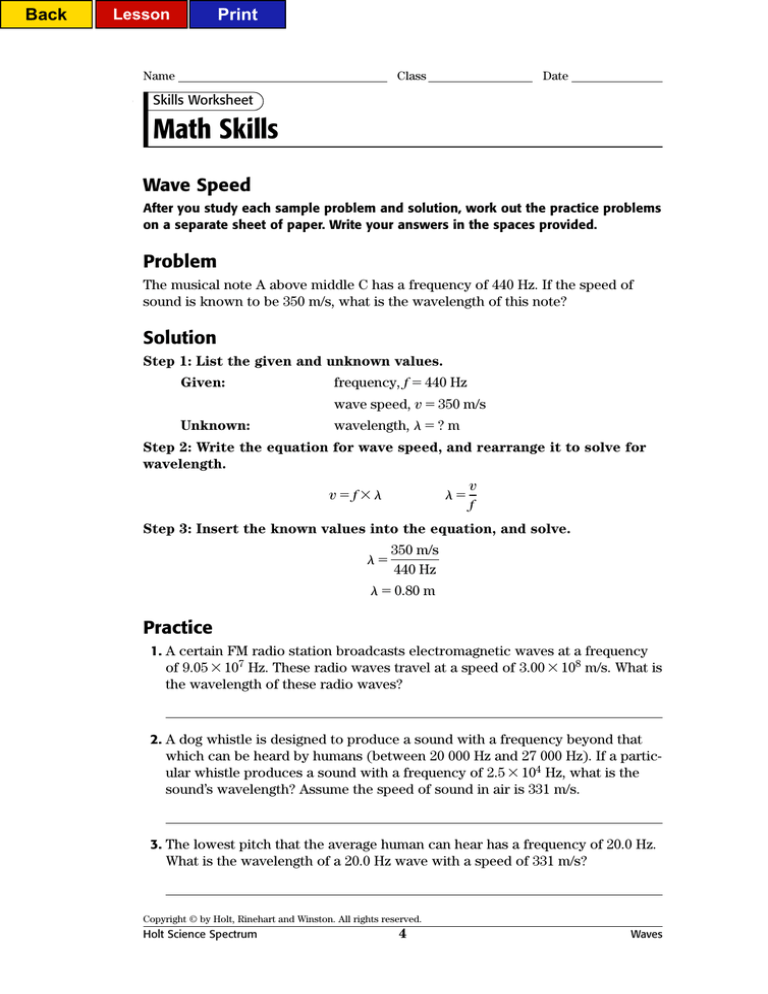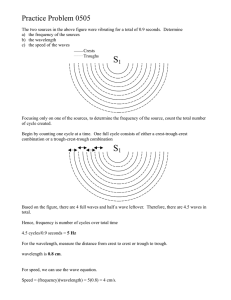
Back
Print
Lesson
Name
Class
Date
Skills Worksheet
Math Skills
Wave Speed
After you study each sample problem and solution, work out the practice problems
on a separate sheet of paper. Write your answers in the spaces provided.
Problem
The musical note A above middle C has a frequency of 440 Hz. If the speed of
sound is known to be 350 m/s, what is the wavelength of this note?
Solution
Step 1: List the given and unknown values.
Given:
frequency, f 440 Hz
wave speed, v 350 m/s
Unknown:
wavelength, ? m
Step 2: Write the equation for wave speed, and rearrange it to solve for
wavelength.
vf
v
f
Step 3: Insert the known values into the equation, and solve.
350 m/s
440 Hz
0.80 m
Practice
1. A certain FM radio station broadcasts electromagnetic waves at a frequency
of 9.05 107 Hz. These radio waves travel at a speed of 3.00 108 m/s. What is
the wavelength of these radio waves?
2. A dog whistle is designed to produce a sound with a frequency beyond that
which can be heard by humans (between 20 000 Hz and 27 000 Hz). If a particular whistle produces a sound with a frequency of 2.5 104 Hz, what is the
sound’s wavelength? Assume the speed of sound in air is 331 m/s.
3. The lowest pitch that the average human can hear has a frequency of 20.0 Hz.
What is the wavelength of a 20.0 Hz wave with a speed of 331 m/s?
Copyright © by Holt, Rinehart and Winston. All rights reserved.
Holt Science Spectrum
4
Waves
Back
Print
Lesson
Name
Class
Date
Math Skills continued
4. A 10.0 m wire is hung from a high ceiling and held tightly below by a large
mass. Standing waves are created in the wire by air currents that pass over
the wire, setting it in motion. If the speed of the standing wave is 335 m/s and
its frequency is 67 Hz, what is its wavelength?
5. Sonar is a device that uses reflected sound waves to measure underwater
depths. If a sonar signal has a frequency of 288 Hz and the speed of sound in
water is 1.45 103 m/s, what is the wavelength of the sonar signal?
Problem
A buoy bobs up and down in the ocean. The waves have a wavelength of 2.5 m,
and they pass the buoy at a speed of 4.0 m/s. What is the frequency of the waves?
How much time does it take for one wave to pass under the buoy?
Solution
Step 1: List the given and unknown values.
Given:
wavelength, 2.5 m
wave speed, v 4.0 m/s
Unknown:
frequency, f ? Hz
period, T ? s
Step 2: Write the equation for wave speed, and rearrange it to solve for
frequency. Write the equation for period.
vf
f
T
v
1
f
Step 3: Insert the known values into the equations, and solve.
f
4.0 m/s
2.5 m
f 1.6 Hz
1
T
1.6 Hz
T 0.62 s
Copyright © by Holt, Rinehart and Winston. All rights reserved.
Holt Science Spectrum
5
Waves
Back
Print
Lesson
Name
Class
Date
Math Skills continued
Practice
6. Cicadas produce a buzzing sound that has a wavelength in air of
2.69 m. If the speed of sound in air is 346 m/s, what is the frequency of the
sound produced by a cicada? What is its period?
7. A drum is struck, producing a wave with a wavelength of 110 cm and a speed
of 2.42 104 m/s. What is the frequency of the wave? What is the period?
8. One of the largest organ pipes is in the auditorium organ in the convention
hall in Atlantic City, New Jersey. The pipe is 38.6 ft long and produces a sound
with a wavelength of about 10.6 m. If the speed of sound in air is 346 m/s,
what is the frequency of this sound?
9. Yellow light with a wavelength of 5.89 107 m travels through
quartz glass with a speed of 1.94 108 m/s. What is the frequency of the light?
Problem
Waves in a lake are 6 m apart and pass a person on a raft every 2 s. What is the
speed of the waves?
Solution
Step 1: List the given and unknown values.
Given:
wavelength, 6 m
period, T 2 s
Unknown:
wave speed, v ? m/s
Step 2: Write the equations for period and wave speed. Calculate the frequency from the period, and then determine the wave speed.
f
1
T
vf
Step 3: Insert the known values into the equations, and solve.
f
1
0.5 Hz
2s
v (0.5 Hz) (6 m)
v 3 m/s
Copyright © by Holt, Rinehart and Winston. All rights reserved.
Holt Science Spectrum
6
Waves
Back
Lesson
Print
Name
Class
Date
Math Skills continued
Practice
10. A wave with a frequency of 60.0 Hz travels through vulcanized rubber with a
wavelength of 0.90 m. What is the speed of this wave?
11. A wave with a frequency of 60.0 Hz travels through steel with a wavelength of
85.5 m. What is the speed of this wave?
Mixed Practice
12. Earthquakes generate shock waves that travel through Earth’s interior to
other parts of the world. The fastest of these waves are longitudinal waves,
like sound waves, and are called primary waves, or just p-waves. A p-wave
has a very low frequency, typically around 0.050 Hz. If the speed of a p-wave
with this frequency is 8.0 km/s, what is its wavelength?
13. Earthquakes also produce transverse waves that move more slowly than the
p-waves. These waves are called secondary waves, or s-waves. If the wavelength of an s-wave is 2.3 104 m, and its speed is 4.5 km/s, what is its frequency?
14. A dolphin can typically hear sounds with frequencies up to 150 kHz. What is
the speed of sound in water if a wave with this frequency has a wavelength of
1.0 cm?
15. A ship anchored at sea is rocked by waves that have crests 14 m apart. The
waves travel at 7.0 m/s. How often do the wave crests reach the ship?
Copyright © by Holt, Rinehart and Winston. All rights reserved.
Holt Science Spectrum
7
Waves
Back
Lesson
Print
TEACHER RESOURCE PAGE
Math Skills
SECTION: WAVE INTERACTIONS
1. a. The waves would bounce, or reflect,
WAVE SPEED
off the surface or boundary. Example:
light reflecting off a mirror b. The
waves would bend, or diffract, as they
passed the edge or opening. Example:
hearing voices outside the doorway of
a classroom (sound waves diffract
around the doorway) c. The waves
would bend, or refract, as they passed
from one medium to another (unless
they met the boundary straight on).
Example: a spoon in a glass of water
that looks divided in two (light waves
from the spoon inside the water are
bent when they pass from water into
glass, then into air) d. The waves
would interfere, or be added or subtracted, as they passed through one
another. Example: ripples overlapping
on the surface of a pond, producing
interference patterns.
2. Check students’ drawings. Waves that
interfere constructively should have
crests and troughs lined up with each
other, and the resulting wave should
be larger than either of the original
waves. Waves that interfere destructively should not have crests and
troughs lined up, and the resulting
wave should be smaller than the larger
of the original waves. Use Figure 20
in the textbook as a reference.
3. 1.0 m
1 wavelength
v 3.00 108 m/s
1. 3.32 m
f 9.05 107 Hz
331 m/s
v
2. 0.013 m
f 2.5 104 Hz
v 331 m/s
3. 16.6 m
f 20.0 Hz
v 335 m/s
4. 5.0 m
f
67 Hz
v 1.45 103 m/s
5. 5.03 m
f
288 Hz
v 346 m/s
6. f 129 Hz
2.69 m
1
1
T 7.75 103 s
f 129 Hz
v 2.42 104 m/s
7. f 2.2 104 Hz
1.1 m
1
1
4.5 105 s
T f 2.2 104 Hz
v 346 m/s
8. f 32.6 Hz
10.6 m
v 1.94 108 m/s
9. f 3.29 1014 Hz
5.89 107 m
10. v f (60.0 Hz) (0.90 m)
54 m/s
11. v f (60.0 Hz) (85.5 m)
5.13 103 m/s
v 8.0 103 m/s
12. 1.6 105 m
f
0.050 Hz
v 4.5 103 m/s
13. f 0.20 Hz
2.3 104 m
14. v f 1.5 m
1.5 wavelength
1.0 m
(1.5 105 Hz) (1.0 102 m)
1.5 103 m/s
v 7.0 m/s
15. f 0.50 Hz
14 m
1
1
T 2.0 s
f 0.50 Hz
One wave reaches the ship every 2.0 s.
Copyright © by Holt, Rinehart and Winston. All rights reserved.
Holt Science Spectrum
74
Waves





